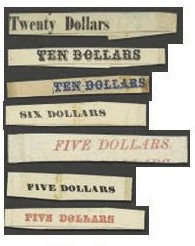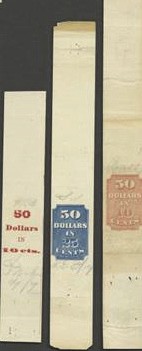
PREV ARTICLE
NEXT ARTICLE
FULL ISSUE
PREV FULL ISSUE
ORIGINAL BANDED FRACTIONAL PACKS
We love obscure numismatic topics here at The E-Sylum. Here's an excerpt from an article about banded packs of U.S. Fractional
Currency notes by Rick Melamed in the September/October 2015 issue of Paper Money, a publication of the Society of Paper Money
Collectors. Many thanks to editor Benny Bolin for forwarding the text and images. -Editor
In my early days as a fractional collector (in the late 1980s), I was making my way down the aisles at a coin show. At one table, a dealer had broken open a pack of FR1309 5th 25¢ Walker notes. In his case was (40) gem Walkers, looking shiny and new, fanned out for maximum appeal. The dealer said to me,”take your pick of any Walker in my case, and I’ll let you have it for $40 (give or take).” I went through the notes; picked out the best one, and thought to myself I did well. I noticed the band, discarded at the side of his case, and had to ask, “Why did you break open the pack?” He told me that there was more money to be made selling them individually than as a pack of 40. My initial reaction was sympathetic to his perspective, but, in the process of squeezing out a few more dollars, a part of fractional history was lost forever. As a single piece of currency, the Walker is just a common fractional note. But, as a banded pack, it becomes a romantic piece of history; a survivor from a bygone era. Those (40) Walkers were a band of brothers bound through the decades by an ornate “TEN DOLLARS” band with a proud and elegant design. 
A pack of fractionals assembled and banded in the 1870’s represents how bank commerce was transacted; no doubt it was in a teller’s drawer. Perhaps it was withdrawn by a merchant to make change at his local business. Like rolls of nickels, dimes and quarters today, the merchant left the bank that day with several packs. Whatever circumstances arose, that one single pack of Walkers was never opened; stashed away for posterity. Fast forward to that fateful day, over 100 years later, when this dealer destroyed a part of fractional lore for a few more dollars. In no uncertain terms, this was shameful act of self-interest. Banded packs (as well as sheets) have risen considerably in value as the available supply diminishes. The sum is now worth more than the parts. While this is self-correcting, one cannot help and think of that pack lost forever in the 1980s. Banded packs have become quite rare, and there are only a few varieties available today. Part of the appeal is the actual bands. From the Tom O’Mara sale in 2005, the following Heritage lot description gives us great insight on how fractionals were bundled. The lot description reads as follows: Lot 15679 - An Incredible Collection of Fractional Currency Treasury Bands. Tom has acquired a group of ten different bands, several of which we have never seen before, including three larger bands apparently intended to hold multiple bundles. The largest was intended for $50 in 10¢ notes. We've seen individual ordinary bands sell in the $25 range and suspect that this irreplaceable group of ten should be worth at least...(sold for $488.75).  
The bands give us a more textured reminder of the past than a single note. The ‘SIX DOLLARS’ band is especially intriguing… perhaps it was a band from a pack of (200) third issue 3¢ fractionals. Wayne Homren, Editor The Numismatic Bibliomania Society is a non-profit organization promoting numismatic literature. See our web site at coinbooks.org. To submit items for publication in The E-Sylum, write to the Editor at this address: whomren@gmail.com To subscribe go to: https://my.binhost.com/lists/listinfo/esylum All Rights Reserved. NBS Home Page Contact the NBS webmaster 
|